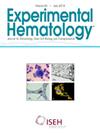定义小胶质细胞表观基因组结构和转录组的转录因子。
IF 2.1
4区 医学
Q2 HEMATOLOGY
引用次数: 0
摘要
小胶质细胞是大脑中的巨噬细胞,在维持大脑健康方面起着至关重要的作用。最近的全基因组分析,包括ATAC-seq, ChIP-seq/CUT&RUN和单细胞RNA-seq,已经确定了定义小胶质细胞转录组程序的关键转录因子。四个转录因子pu。1、IRF8、SALL1和smad4形成增强子复合物,并作为谱系决定因子,塑造小胶质细胞的身份。这些因子与其他决定谱系的转录因子结合,将其中一个导向小胶质细胞编程的指定区域,同时抑制另一个与DNA结合。其他转录因子,如BATF3和MAFB,参与小胶质细胞的转录级联反应。TGF-β是驱动这些转录因子结合DNA并维持小胶质细胞稳态的关键细胞因子。这些发现为小胶质细胞的生理方面及其在神经炎症和神经退行性疾病中的作用提供了见解。摘要:在这篇文章中,我们收集了100多个在小胶质细胞中表达的转录因子。我们的分析表明,一些转录因子处于不同的等级等级下,并被顺序激活以实现小胶质细胞特异性转录组程序。本文为小胶质细胞复杂活动的机制基础提供了一个新的视角。本文章由计算机程序翻译,如有差异,请以英文原文为准。
Transcription factors that define the epigenome structures and transcriptomes in microglia
Microglia, the resident macrophages of the brain, play critical roles in maintaining brain health. Recent genome-wide analyses, including ATAC-seq, ChIP-seq/CUT&RUN, and single-cell RNA-seq, have identified key transcription factors that define the transcriptome programs of microglia. Four transcription factors—PU.1, Irf8, Sall1, and Smad4—form enhancer complexes and act as lineage-determining factors, shaping microglial identity. These factors co-bind with other lineage-determining transcription factors, directing one toward designated regions that program microglia while inhibiting the other from binding to DNA. Other transcription factors, such as Batf3 and Mafb, contribute to transcriptional cascades in microglia. TGF-β is a crucial cytokine driving these transcription factors to bind DNA and maintain homeostatic microglia. These findings provide insights into the physiological aspects of microglia and their roles in neuroinflammatory and neurodegenerative diseases.
求助全文
通过发布文献求助,成功后即可免费获取论文全文。
去求助
来源期刊

Experimental hematology
医学-血液学
CiteScore
5.30
自引率
0.00%
发文量
84
审稿时长
58 days
期刊介绍:
Experimental Hematology publishes new findings, methodologies, reviews and perspectives in all areas of hematology and immune cell formation on a monthly basis that may include Special Issues on particular topics of current interest. The overall goal is to report new insights into how normal blood cells are produced, how their production is normally regulated, mechanisms that contribute to hematological diseases and new approaches to their treatment. Specific topics may include relevant developmental and aging processes, stem cell biology, analyses of intrinsic and extrinsic regulatory mechanisms, in vitro behavior of primary cells, clonal tracking, molecular and omics analyses, metabolism, epigenetics, bioengineering approaches, studies in model organisms, novel clinical observations, transplantation biology and new therapeutic avenues.
 求助内容:
求助内容: 应助结果提醒方式:
应助结果提醒方式:


